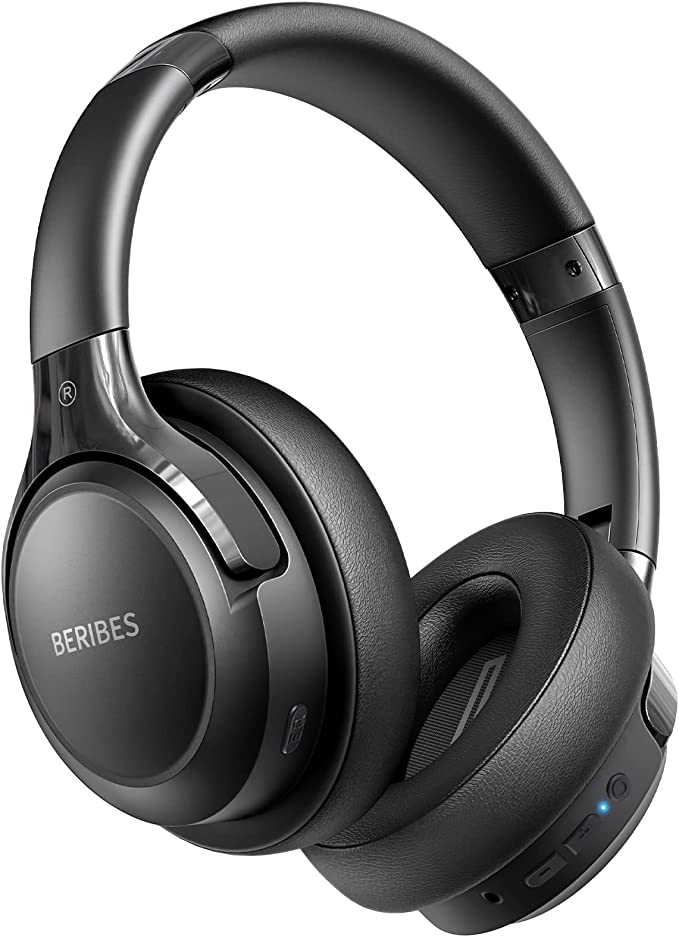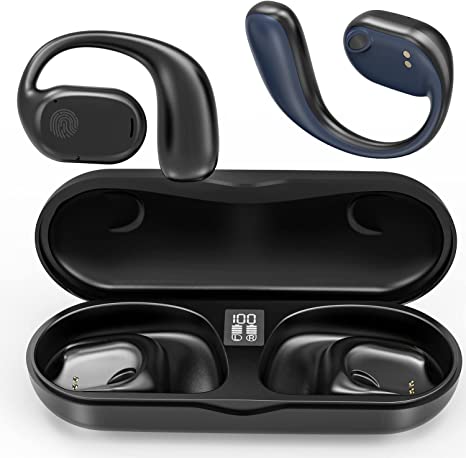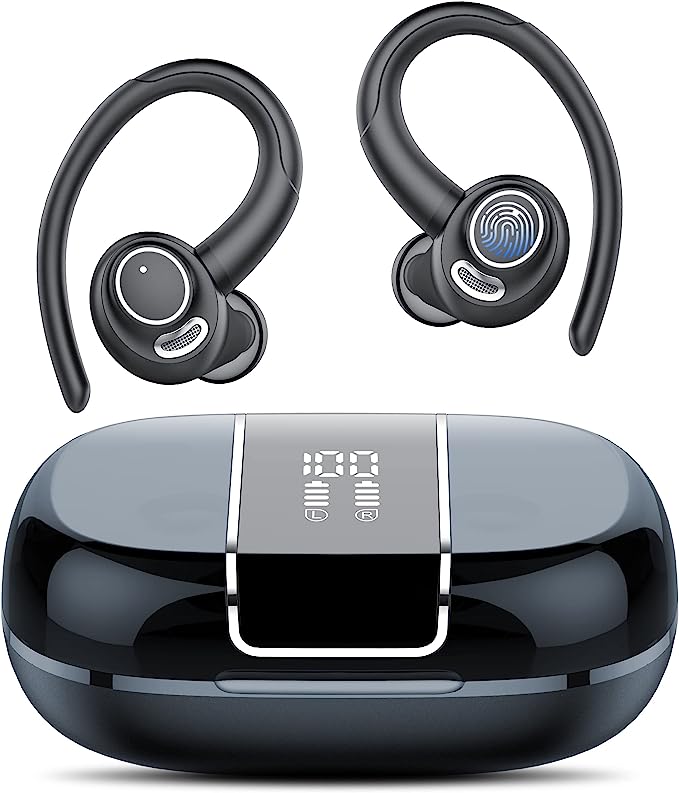We live in an era quietly saturated with invisible connections. Perhaps one of the most profound daily freedoms gifted to us by modern technology is the liberation from audio cables. Remember the days of untangling headphone wires snagged on doorknobs or coat buttons? Wireless audio promised freedom, a seamless flow between our digital lives and our physical movement. Yet, early iterations often stumbled, tethered by short battery life or compromised sound quality.
Fast forward to today, and the landscape has dramatically shifted. Devices like the BERIBES 202A Bluetooth Headphones represent a fascinating point in this evolution. While readily accessible, they often pack features that were once the domain of high-end equipment. But this isn’t just about listing features off a box. Let’s, together, pull back the curtain and explore the fascinating science and engineering principles that allow headphones like these to offer experiences such as marathon-like battery life and sound tailored precisely to your liking. Think of this less as a review, and more as a journey into the heart of everyday audio technology.

The Unending Playlist: Deconstructing 65 Hours of Freedom
What’s one of the biggest anxieties in our always-on, wirelessly connected world? The dreaded low-battery warning. The quest for devices that simply keep going is universal. When a product description, like that for the BERIBES 202A, mentions a staggering 65-hour playtime, it speaks directly to this desire. This isn’t just a number; it represents a significant slice of freedom – the freedom to travel across continents, power through multiple work weeks, or simply forget where you last left the charging cable, all without your personal soundtrack cutting out.
But how is such endurance possible in a relatively compact device? It’s a tale of two crucial advancements working in concert: energy storage and energy efficiency.
A Peek Inside the Power Pack: At the heart of most modern wireless headphones lies a Lithium-ion (Li-ion) battery. You could picture it as a highly sophisticated “energy backpack.” Over the past few decades, relentless research in materials science and electrochemistry has dramatically increased the energy density of these batteries. In simple terms, engineers have figured out how to pack significantly more electrical energy into the same physical space, or even less. This breakthrough was fundamental to the miniaturization of portable electronics, from smartphones to headphones. Early portable audio players were often bulky specifically because their power sources were less efficient. Today’s Li-ion cells are marvels of chemical engineering, storing substantial power in lightweight forms.
The Art of Sipping Power: However, having a large energy backpack is only half the story. Imagine trying to make a full water bottle last for days – you’d need to sip it very carefully! Similarly, achieving long playtime requires the headphones’ components to be incredibly power-efficient. This is where modern chipsets shine. The Bluetooth chip, responsible for maintaining that stable wireless link, and the audio processing circuits, which handle decoding the music and driving the speakers, have become masters of energy conservation. Influenced by standards like Bluetooth Low Energy (BLE), which prioritizes minimal power draw for maintaining connections, these components perform their complex tasks while consuming minuscule amounts of power compared to their predecessors.
Therefore, achieving a claimed 65 hours of playtime, as mentioned for the 202A, isn’t typically down to just stuffing in the largest possible battery (which would add weight and bulk). It signifies a balanced design – a reasonably dense battery paired with components meticulously engineered to sip, rather than gulp, energy. It’s this synergy between storage and efficiency that translates into that liberating multi-day (or even multi-week, for lighter users) listening experience. Imagine flying from London to Sydney, enjoying music or movies throughout the near-24-hour journey, and still having plenty of charge left upon arrival – that’s the kind of practical freedom this level of endurance unlocks.

Your Sound, Your Rules: The Symphony of 6 EQ Modes
Sound is deeply personal. The thumping bass that energizes one person’s workout might be distracting noise to someone else trying to focus on a podcast. A “flat” or perfectly neutral sound reproduction, while technically accurate (the goal of “HiFi” or High Fidelity), might not always be the most enjoyable for every type of music or listening environment. This is where the concept of Equalization, or EQ, becomes invaluable. The BERIBES 202A’s product description highlights 6 EQ Music Modes, offering a way to tailor the sound signature to your preference or content.
Painting with Sound Frequencies: Think of the audible sound spectrum like a rainbow, ranging from the deep, vibrating reds of low bass frequencies, through the yellows and greens of mid-range frequencies where vocals and most instruments reside, up to the bright blues and violets of high-treble frequencies that give sound its crispness and air. An equalizer acts like a set of sophisticated filters or volume controls for different bands within this rainbow. It allows you to boost (turn up) or cut (turn down) specific frequency ranges.
This process is typically handled digitally by a tiny powerhouse inside the headphones known as a Digital Signal Processor (DSP). This chip takes the incoming audio stream and mathematically alters the levels of different frequencies according to the selected EQ profile before sending the signal to the headphone speakers. Want that “Deep Bass” mentioned in the 202A’s description? The DSP executes an EQ setting that significantly boosts the low-frequency “reds” of the sound rainbow.
Why Six Flavors? The Power of Presets & Psychoacoustics: Why offer multiple modes instead of complex manual controls? Convenience. Presets provide quick, optimized settings for common scenarios. While we don’t know the specific labels of the 202A’s six modes, typical presets might include “Bass Boost,” “Vocal Booster” (enhancing mid-range for podcasts/audiobooks), “Treble Booster” (for perceived clarity), “Rock,” “Pop,” or a balanced “Flat” mode.
The effectiveness of these modes leans heavily on the fascinating field of psychoacoustics – the study of how humans perceive sound. Our ears and brains don’t perceive all frequencies equally. For instance, at lower volumes, our perception of very low and very high frequencies diminishes (as described by the Fletcher-Munson curves or equal-loudness contours). EQ can compensate for this or deliberately shape the sound for emotional impact. Boosting bass frequencies often correlates with feelings of power and warmth. Enhancing upper mid-range can make vocals seem more present and intimate. The goal of multiple EQ modes is to leverage these perceptual effects, allowing you to instantly shift the sonic character to best suit the moment – transforming your headphones from a neutral conduit into a personalized sound shaper. Imagine effortlessly switching from an EQ mode that makes your electronic dance music pulse with energy during your workout, to one that renders dialogue crisp and clear for your evening podcast listening – that’s the practical magic of well-implemented EQ presets.

Connections That Count: Wireless, Wired, and Voice
The core appeal of headphones like the BERIBES 202A is undoubtedly their Wireless nature, powered by Bluetooth. This remarkable technology uses short-range radio waves (typically in the 2.4 GHz band, similar to Wi-Fi but with different protocols) to transmit audio data from your phone, computer, or tablet directly to your ears. It’s a complex dance of encoding, transmitting, receiving, and decoding, all happening seamlessly to provide that liberating untethered experience. Bluetooth isn’t static; it’s a constantly evolving standard, with newer versions generally offering improvements in range, stability, data bandwidth, and, crucially for battery life, power efficiency.
However, versatility often lies in having options. The inclusion of a Wired connectivity option is a thoughtful touch. Think of it as a trusty lifeline. Run out of battery unexpectedly? Plug in the cable and keep listening (passive mode, usually). Want to connect to an older device without Bluetooth, like an airplane’s entertainment system or a vintage MP3 player? The wired jack is your friend. Furthermore, for certain critical listening applications like audio production or competitive gaming, a wired connection completely eliminates the small (but sometimes perceptible) audio latency or delay inherent in any wireless transmission, ensuring perfect synchronization between sound and action.
Beyond listening, modern headphones are often communication hubs. The integrated Microphone transforms the 202A from just a listening device into a tool for interaction. Using tiny components (often MEMS – Micro-Electro-Mechanical Systems – microphones today) that convert sound waves into electrical signals, it allows for hands-free phone calls, participation in video conferences (a staple of the home office), and interaction with voice assistants like Siri or Google Assistant. It’s another layer of convenience woven into the fabric of modern mobile life.
Wearing the Sound: Comfort, Design, and Acoustics
How headphones feel is just as important as how they sound, especially for extended use. The Over-Ear design of the BERIBES 202A, where the earcups fully enclose the ears, offers several potential benefits rooted in acoustics and ergonomics. Acoustically, this design can create a better seal around the ear, providing a degree of passive noise isolation – essentially, physically blocking out some ambient sounds from the environment. This can lead to a more immersive listening experience, allowing you to focus on your audio without needing to crank up the volume excessively. The larger earcups also provide more internal volume, which can be beneficial for creating a more open and spacious soundstage (the perceived sense of width and depth of the audio).
The description also highlights Lightweight and Foldable characteristics. These are direct results of careful choices in material science and mechanical engineering. Modern plastics and alloys can provide surprising strength and durability while keeping weight to a minimum. Reducing weight is critical for long-term comfort; heavier headphones can cause neck strain or pressure points over time. Being Foldable adds a crucial layer of practicality. Hinges and swiveling mechanisms, engineered to be robust yet smooth, allow the headphones to collapse into a more compact form. Think of it like clever origami for your ears, making them much easier to tuck into a bag or drawer when not in use, enhancing their portability for life on the move. Comfort isn’t a luxury; it’s fundamental to usability, ensuring the technology serves you without becoming a burden.

Conclusion: Technology Democratized, Experiences Personalized
Exploring the features mentioned for the BERIBES 202A headphones reveals a microcosm of modern technological convergence. That impressive 65-hour playtime isn’t just one component; it’s the culmination of advances in battery chemistry and low-power semiconductor design. The customizable sound from the 6 EQ modes relies on sophisticated digital signal processing informed by decades of research into acoustics and human hearing. The seamless wireless connection, the backup wired option, the tiny microphone enabling communication, and the ergonomic design focusing on lightweight comfort and portability – each element draws upon distinct fields of science and engineering.
What’s perhaps most remarkable is how these once-premium capabilities are increasingly finding their way into accessible devices. It signifies a powerful trend: the democratization of technology. Features that enhance our daily lives – providing longer operational freedom, allowing personalized audio experiences, and ensuring comfortable, practical use – are no longer confined to the highest price brackets.
As we look ahead, the evolution of personal audio will undoubtedly continue. We might see even smarter power management, more sophisticated AI-driven sound personalization, deeper integration with augmented reality, or perhaps entirely new ways of interacting with sound. But the core principles will likely remain: leveraging scientific understanding to create devices that not only deliver sound but also enhance our connection to the world, our work, and ourselves, all while becoming increasingly seamless extensions of our lives. The journey of headphones like the BERIBES 202A reminds us that even everyday objects can be packed with fascinating science, working quietly to bring us a little more freedom and joy.




